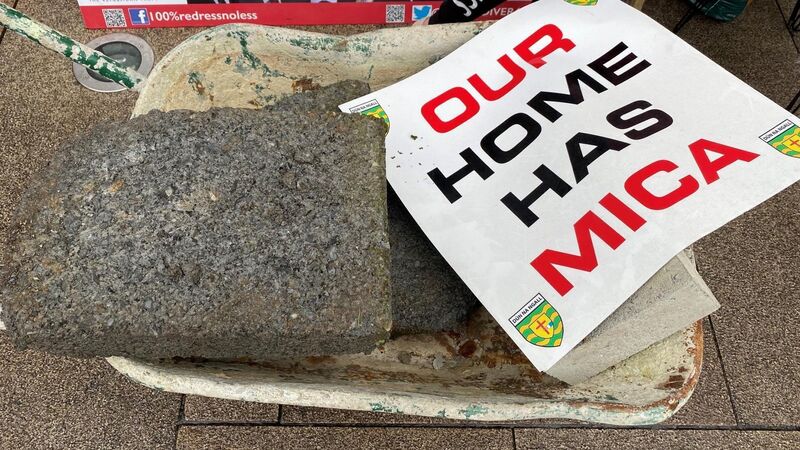Mick Clifford: When the levy breaks, we all end up paying the bill

The 10% toll on concrete products which was forecast to generate €80m annually was to go towards a bill to replace or repair homes destroyed by mica in concrete blocks. The total bill is estimated to be just short of €3bn. Picture: Dominic McGrath/PA Wire
Rowing back from a bad decision is never easy, but it can also present an opportunity. Such an opportunity arose in the Government’s decision this week to take another stab at imposing a levy on concrete products after the initial design met with major political opposition.
Unfortunately, there was no stomach to address the issue properly and once again short-term politics has won out over prudent and fair governance.
The initial levy, introduced to help fund a redress scheme for those affected by the defective concrete blocks, was appallingly designed.
The proposal, announced by Paschal Donohoe in his budget speech, involved a 10% toll on concrete products which was forecast to generate €80m annually. This was to go towards a bill to replace or repair homes destroyed by mica in concrete blocks. The total bill is estimated to be just short of €3bn.
Immediately on the announcement, the construction industry was pointing out that the levy would be borne by first-time buyers.
Backbenchers got it in the ear and demanded a row back. To be fair, asking one section of the construction industry to stump up a levy of 10% was unrealistic. There was simply no way such a major cost could be absorbed by the system.
Now in the finance bill, the levy has been reduced to 5%, it will only be tolled on blocks and not all concrete products and it won’t be introduced until September next year. The amount of revenue to be generated is now expected to be €30m rather than €80m.
This represents a complete cop-out, exercised through our old friend the knee-jerk reaction. Practically all parties and politicians agree that a levy of some description should be imposed on the construction industry for various redress schemes.
Apart from mica, there is already a redress scheme in operation for pyrite found in house foundations. An even bigger bill has to be paid in respect of apartments rendered dangerous through fire safety and structural defects.
The expert report on apartment defects published last July set out that up to 100,000 apartments built between 1991 and 2013 are affected.
While some builders maintained high standards through the frantic days of the Celtic Tiger, many did not, to the extent that cutting corners was systemic. The bill for defective apartments is estimated at €3bn.
If past trends are anything to go by, the total bill for mica, defective apartments and pyrite could well be heading for €10bn. Yet, as of now, the only toll on any element of the construction or development industries is a Mickey Mouse levy that has already been watered down.
What is so special about the construction industry? In 2013, a levy was introduced on banks to assist in the national recovery. The premise for doing so was the bank’s centrality in driving the State onto the rocks in the 2008 economic collapse.
A 1% levy on total deposits was introduced which initially generated €150m a year. This is as it should be. Negligent — and at times duplicit banking — exercised a terrible toll on the public finances which was felt keenest by those at the lower rungs of the socio-economic ladder.
In 2012, the government introduced a levy on the insurance industry called the Insurance Compensation Fund. It is tolled at 2% of total premiums across the industry. The levy was designed to cover the cost of claims that resulted from the collapse of Quinn Insurance, another outfit that lost the run of itself during the tiger years.
Previously, the levy had been in place between 1984 and 1992 to cover the cost of the collapse of the AIB-owned Insurance Corporation of Ireland.
The levy is tolled at a level that is manageable and can be absorbed. Yet, for some reason, this approach is not being adopted in dealing with the systemic reckless behaviour of large elements of the construction industry.
When his initial proposal was declared dead in the water, Donohoe had an opportunity to design a more far-reaching plan that would both spread the financial pain and dilute any blowback on first-time buyers.
A levy that would generate funds for all the redress schemes, and not just mica, is badly needed. Impose it on profits right across the industry, including on elements like banking and insurance, and set it at a low rate would be equitable and fair.
Sinn Féin proposed something along these lines but there would have been scope enough to deviate from its proposal if the political optics were a major concern for Donohoe.
Instead, the Government is effectively throwing in the towel. Huge sums of money will now be drained directly from central funding to properly compensate those affected by faulty construction of one sort or another.
And when there is a requirement to tighten budgets, it is those who are most in need of State assistance and those with least political influence who will be first in line for cuts.
It’s a shabby way to address a serious problem that had impacted hugely on thousands of citizens.















